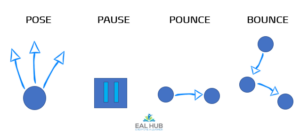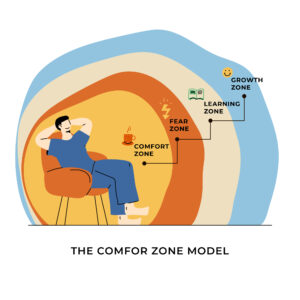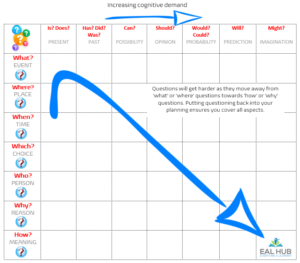
EAL Questioning Strategies
One area that EAL learners often find challenging is when asked questions during lessons. The reason for this is that it usually happens too fast. Beth Southern offers some questioning strategies that EAL students find particularly helpful.
Working with EAL learners is not about changing everything you do; it’s not about differentiating everything ‘down’. Working with EAL learners is about finding ways to give more time, to provide opportunities to add extra steps into a task and to scaffold those learners to reach their best potential through literacy support.
Research shows that the average question is asked and answered in a classroom within 60 seconds. When you consider the process that a child learning English goes through to reach their answer – hear the question in English, convert it to their first language, formulate the answer in their first language and then convert back to English – you can see why 60 seconds is nowhere near enough.
So what do teachers need to do to overcome this particular hurdle? How can we assess children in a way that allows more children chance to answer? We need to start by putting questioning back at the heart of planning – ensuring we know what we are trying to assess and how we are going to do it. As teachers get more experienced, it is easy to slip into the habit of not using questioning as the effective tool it can be, relying on hands up for answers, focusing on recall only and evaluating answers given. What about if we switch things up and hand it back over to the students more?
This article is going to look at five questioning ideas that you can try in your classroom, they are not just ‘EAL friendly’, they will also benefit nervous children, children with SEND or literacy needs. The beauty of them is their versatility, their low preparation time and their high engagement rate.
Pose, Pause, Pounce, Bounce
So how does it work?

POSE – The teacher would pose a question to the whole class. PAUSE – The whole class would pause and think (this is important for EAL learners – build in wait time). POUNCE – The teacher figuratively ‘pounces’ on a student for a response – the great thing about this is that students all know they could be asked and so are better primed to reply (students need to be trained in these techniques to make them most effective). A tip when you have EAL learners is to not ask them for the first response, they can then listen to earlier responses and confirm their ideas in their head.
Often after receiving a reply from a student we, as teachers, evaluate that reply, add more or disagree and then move on. But not with this technique.
BOUNCE – The teacher will then bounce that child’s response to another child for them to discuss, add more, disagree etc. If a child feels unable to offer a response then you can let them know you’ll come back to them after they have heard more ideas, to see if they can then add something – this again builds more processing time.
Talk is so important for EAL learners. This strategy reduces teacher talk time and increases student talk time. It also enables learners to see that they don’t always have to answer fully, they can offer part of a response or a simple idea or word and then have it bounced elsewhere, reducing the cognitive load around questioning and reducing potential anxiety.
Reducing cognitive load is a key part of working with EAL learners, it is why we often provide writing frames, partial responses or additional scaffolding materials because there is less to then be overwhelmed with and they can focus on the parts that matter most. Comprehension activities can often cause stress for EAL learners as they are faced with what seems like a huge task – read a piece of text and answer 10 questions silently and in writing. A way round this can be to split the activity between 4-5 children, give each student 2-3 questions and then after they have found those answers they talk as a group to ‘teach’ each other the answers for the additional questions. Rather than being faced with a piece of text and 10 questions, it suddenly seems much more manageable with just 2-3 questions followed by discussion with peers to find out the other answers.
Similar to this method is another one that I particularly like for EAL learners – Pose a question for a group to discuss. Listen in and paraphrase back to the class on their behalf. This again reduces the cognitive load by having many brains working on questions rather than one. It allows EAL learners to listen in, hear good role models of English and add when they can. As mentioned above, talk is important for EAL learners who use it to help formulate answers in their head, before they begin to write. This method could then be supplemented with a writing frame for them to write the answers that they have discussed. Add in visual support to assist with abstract concepts and you have fully supported the needs of the EAL learners to achieve the best they can.
Think-Pair-Share – Most teachers know and use ‘think-pair-share’, but with EAL learners it is important to ensure that it is being used effectively to help them develop language and understanding. The first part of this technique requires the student to THINK about a question that has been posed, similarly, to the part where we PAUSE in the strategy above, it’s important to ensure that students are actually thinking about the question or using the time to formulate their answers. I like the idea of getting children to have mini whiteboards and adding something to that during the thinking phase – whether it is just key words, a drawing/diagram, or a full answer isn’t important. What matters is that they are focused on the question, and you are able to assess without the need to speak. You can see if they have not understood the question or appear to have little comprehension of the topic and you can then intervene during the next stage to ensure they are well-supported.
The second stage is the PAIR stage when they will then compare/combine their answer with a peer – this assists EAL students with getting the correct terminology or language and taking their answer a step further. It also pushes more time in to their answer which is the key for those learning English.
SHARE is the part that allows for crystalising that answer into long term memory, the act of saying it aloud and actually sharing completes the question cycle
and gives the EAL learner the best possible chance of remembering the concept.
Question Matrix – A question matrix is a tool designed with the purpose of introducing us to a hierarchy of questioning. Designed similar to Bloom’s taxonomy or Higher Order Thinking (HOT) questions. As teachers we need to ensure that we are stretching pupils effectively, particularly more advanced bilinguals and we also need to be able to analyse the complexity of the tasks we expect our learners to do. Whilst it is not a bad thing to offer a complex task to an EAL learner, the more complex it is, the more scaffolding is required. So we need to be prepared.
(HOT) questions. As teachers we need to ensure that we are stretching pupils effectively, particularly more advanced bilinguals and we also need to be able to analyse the complexity of the tasks we expect our learners to do. Whilst it is not a bad thing to offer a complex task to an EAL learner, the more complex it is, the more scaffolding is required. So we need to be prepared.
Questioning matrices allow us to offer a variety of questions, moving away from the most common RECALL questions and towards those that require a higher level of thinking, opinion or free choice. Building the confidence of EAL learners is the key and we can do this by ensuring we offer them a range of questions that develop their confidence. Constantly asking questions that are too easy can leave them disengaged and switched off, similarly asking questions that require high levels of comprehension and understanding can leave them feeling inadequate and lacking in confidence. As Vygotsky talked about the Zone of Proximal Development for general learning, it applies directly to questioning techniques also. We need to ensure that we pose the right level of question with the right amount of support to put our students in the best position to make progress. The support can come in a range of ways from peer support, additional thinking time, talking before writing or group work.
The diagram below demonstrates how questions increase in difficulty and how we need to try and build up to those that require high order thinking skills and comprehension. The key in all of this is planning – we need to ensure that we include questioning within our lesson plan so that it becomes a fundamental part of the lesson rather than a quick show of hands.

Beth offers a wide range of training around questioning techniques and so if you’re looking to improve this area of your T&L take a look at available training here.
